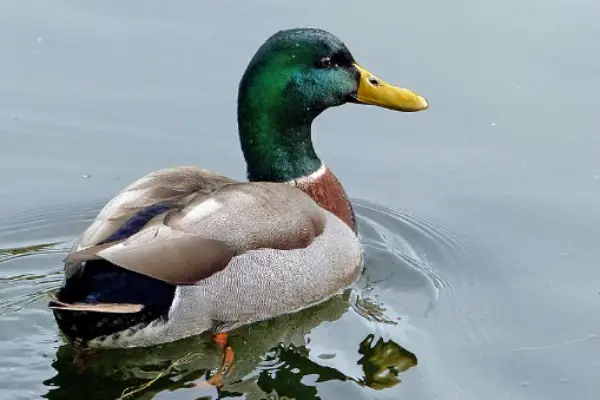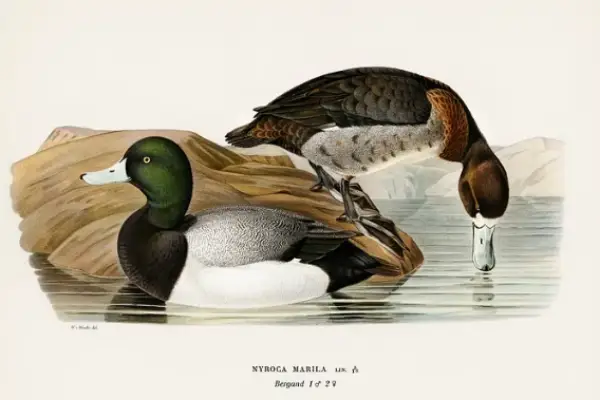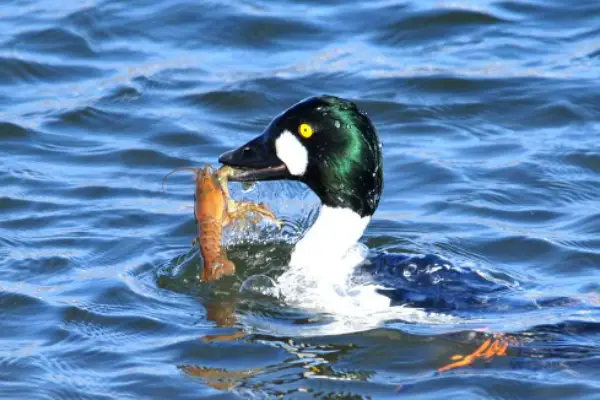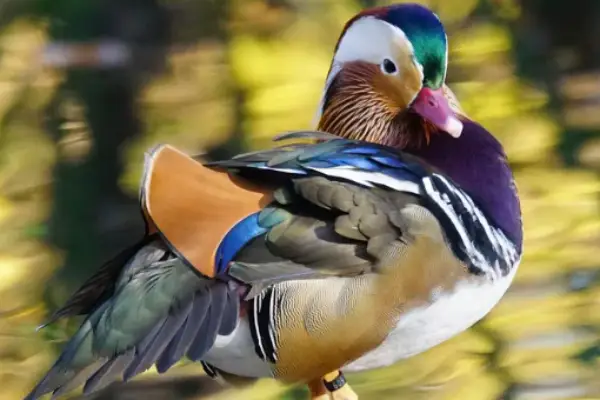We’re back with another post. Today we’ll look at many green and brown duck species seen in nature. While exploring my nearest lake, I came across a green duck species.
When I questioned several locals about it, they said it was a mallard. Curiosity drove me to learn more about these vibrant animals, and I discovered a list of them. I’ve compiled a list of thirteen amazing green and brown duck species for you to enjoy. So let’s get started.
13 Green and Brown Ducks found in nature
1. Mallard

| Scientific name | Anas platyrhynchos |
| Size | 50 to 65 cm |
| Geographic location | Asia, Europe, Africa, North America, South America, and Oceania |
| Identification | Have bright green head and white neck collars |
You must have seen this green beauty in a nearby pond or lake. These versatile ducks are adapted to various habitats all across the world. Meet this mallard duck.
They exhibit sexual dimorphism in terms of hues. The males of this species have an unmistakably glassy bottle green head with a white collar that separates the head from the purple-tinged brown breast, whereas the females have brown plumage.
Extra-pair copulation is seen in this duck species.
2. Greater Scaup

| Scientific name | Aythya marila |
| Size | 39–56 cm |
| Geographic location | Europe, North America, and Asia |
| Identification | Male Scaup in Winters has a dark green-black head and neck and white flanks |
The next green and brown duck species we have on our list is Aythya marila, commonly known as Greater Scaup. They were classified as one of the large duck species because of their typical length of 39 to 56 cm.
Males of this species are so beautiful; they have a dark head with a remarkable green sheen and a blackish brown breast with a white underside.
Females are brown with similar white markings on their wings. One can easily spot these beautiful birds in Europe, North America, and Asia.
3. Common Goldeneye

| Scientific name | Bucephala clangula |
| Size | 15 to 20 inches |
| Geographic location | North America, Europe, and Asia |
| Identification | Have a dark head with greenish gloss and a circular white patch below the eye |
This duck species possesses gorgeous golden-colored eyes, as its common name suggests. Males are stunning, with their bright green glossy black head and circular white patch below the eye.
They have the unusual ability to dive underwater in search of food. This species exhibits brood parasitism as well.
4. Mandarin Duck

| Scientific name | Aix galericulata |
| Size | 41–49 cm |
| Geographic location | Asia, Europe |
| Identification | Males have a white patch around their eyes and a crest of green on the top of their heads |
Here is the largest duck species in the world, Aix galericulata. The males of this duck species have such intriguing plumage that they not only amaze you but also spellbound you.
Males evolve so beautifully to attract their mates by their striking appearance, which includes a red beak, a white patch under the eye, reddish brown whiskers, and a crest of green on the top of their heads.
Mandarin ducks are found in a variety of habitats, including forests, wetlands, and rivers in Asia and Europe.
5. Wood duck
| Scientific name | Aix sponsa |
| Size | 17-20 inches |
| Geographic location | North America, Europe |
| Identification | have an iridescent, bluish-green speculum |
A medium-sized duck of size 17 to 20 inches, Aix sponsa, made its place in the list of 10 remarkable green and brown duck species. Males have an iridescent green and purple head, a brownish breast, and prominent white patterns all over their bodies.
Their name, sponsa, means bride in Latin, and their fascinating look justifies the term. Because of their brilliant characteristics and colors, they are also known as the Picasso of ducks.
6. Common Teal
| Scientific name | Anas crecca |
| Size | 34–43 cm |
| Geographic location | Europe, Asia, Africa, and North America |
| Identification | Have a green swatch just behind their eye |
The Anas crecca is commonly known as the Common Teal or Eurasian Green Winged Tail because of its distinctive green patch of feathers on its wings.
This tiny dabbling duck weighs around 32 to 43 cm. Males of this species have a brown head with a wide green swatch behind the eye. They are highly gregarious, like to form large flocks, and fly very fast with rapid twists and turns.
The habitat of Anas crecca varies depending on the season and the region, from temperate regions to coastal areas.
7. Common Merganser
| Scientific name | Mergus merganser |
| Size | 58–72 cm |
| Geographic location | Europe, Asia, and North America |
| Identification | Have a dark green head and red bill |
Here comes our fish-eating duck, Mergus merganser, which is commonly known as Common Merganser in North America or Goosander in Europe.
Like other duck species, males in this species also show vibrant plumage. They have a white body and a dark black or brown head with green iridescence. Young ones show similar appearances to females.
Their normal sound is a deep, harsh croak, but during the mating season, males on display, as well as young, produce a delicate whistle.
8. Northern Shoveler
| Scientific name | Spatula clypeata |
| Size | 48 cm |
| Geographic location | Europe, Asia, Africa, North America, and South America |
| Identification | have large shovel-shaped bill |
You can find these dabbling duck species in Europe, Asia, Africa, North America, and South America. This duck is known for its large shovel- or spatula-shaped bill.
Males have iridescent green heads, whitish brown chests, and a blue shoulder patch in breeding plumage. Females have a mottled brown coloration with an orange and black beak.
Many Northern shovelers are migratory and migrate to the south in the winter. The bills are adapted in such a way that they filter the food in water, just like a sieve.
9. American Wigeons
| Scientific name | Mareca americana |
| Size | 42–59 cm |
| Geographic location | Canada, the United States, Mexico, the West Indies, and the northernmost parts of South America |
| Identification | Have a pale blue bill with a black tip |
The next green and brown ducks we have on our list are American wigeons, scientifically known as Mareca americana.
They can be found in Canada, the United States, Mexico, the West Indies, and the northernmost parts of South America, inhabiting freshwater lakes, ponds, marshes, and estuaries.
Talking about their appearance, as usual, males are more colorful than females; they have a green patch from their eye to their neck on their brown heads, while females are dull in color. They are robber ducks and are known to rob the food of diving water birds.
10. Bufflehead
| Scientific name | Bucephala albeola |
| Size | 32 to 40 cm |
| Geographic location | North America |
| Identification | have a bulbous head with striking green and brown coloration |
Bufflehead, as the name implies, due to their bulbous head appearance.
Green-winged teals are their biggest rivals in North America. Adult males are brown and white with iridescent green and purple hues and have a large white spot under the eye, which gives them a bulbous appearance, whereas females have a dull gray tone.
They live in small groups in which one of the ducks must be sentry and inform other dangers, like predators, etc.
11. Baikal Teal
| Scientific name | Sibirionetta formosa |
| Size | 39–43 cm |
| Geographic location | eastern Siberia, Russia, Mongolia and North Korea |
| Identification | Have characteristic green and yellow facial pattern |
A green and yellow facial pattern with a brownish hue, a spotted rose-pink breast, and drooping scapulars are some of the characteristic features of Baikal Teal.
They are also known as bimaculate ducks or squawk ducks. They often make specific noises, such as squeaks or whistles, to entice potential partners or to communicate.
Perhaps because they inhabit tall grasslands close to bodies of water, their typical diet consists of seeds, aquatic plants, and insects.
12. Falcated Duck
| Scientific name | Mareca falcata |
| Size | 46 to 53 cm |
| Geographic location | Southeastern Siberia, Mongolia, Northern China, and Northern Japan |
| Identification | have sickle-shaped tertial feathers over the tail |
Just take a look at this type of duck and admire the exquisite creation of nature.
Their heads show an incredible coloration of green and brown with a white neck, and that dark green collar makes them more admirable.
They have characteristic sickle-shaped tertial feathers above the tail, as I have indicated in the table.
In contrast to males, females are much duller in color. Due to their omnivorous nature, they often consume seeds, grains, nuts, mollusks, crustaceans, and larvae.
13. Muscovy Duck
| Scientific name | Cairina moschata |
| Size | 66 to 84 cm |
| Geographic location | Southern USA, Mexico, Argentina and Uruguay |
| Identification | a knob is present over the bill |
The last duck we have on our list of green and brown ducks is a Muscovy duck. A wild Muscovy duck has an interesting look that you will find intriguing.
They are almost black in color, with an iridescent green and brown hue. Males have large white patches all over the body, whereas females have much more white patches.
They are multivoltine and breed about three times a year. They are frequently raised as domestic ducks because of their adaptability to a variety of environments and temperatures.
Conclusion
Here we conclude our article on green and brown duck species. In this article, we learned some interesting facts about these ducks, from feeding to coloration.
Males in almost all of the species are more colorful than females, which becomes a major advantage during breeding season to attract them. There is a lot to explore about these colorful creatures.
We will be back with another colorful article soon; until then, dive into the world of these ducks and appreciate them.
Also Read:

Being a zoology student I’m always been fascinated toward animals especially insects. I love to do research and learn about different animals. As a writer I want to share my thoughts about nature through my articles. Apart from this you can find me exploring the new places and voice notes.
